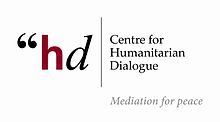Center for Humanitarian Dialogue
The Center for Humanitarian Dialogue , English Center for Humanitarian Dialogue or short HD Center (HDC) is in the Swiss city of Geneva -based independent and impartial humanitarian organization. The main aim of the institution, which is organized as a private foundation, is to prevent and end wars and armed conflicts and to reduce the suffering associated with military conflicts through mediation and direct negotiations between the parties involved. The center emerged in 1998 from the Henry Dunant Institute founded in 1965 .
activities
In line with its goal, the center itself acts as a neutral mediator in armed conflicts. It also helps the negotiating partners in the organization of humanitarian, diplomatic and political aid measures and provides logistical and financial support in the implementation of negotiations. The HDC acts as an advisor on mediation issues for international political organizations, governments and humanitarian organizations. For example, it provides a “ Humanitarian Negotiation Manual ” and organizes conferences and training courses for employees of humanitarian organizations.
In 2005 the HDC was involved in eight conflict regions around the world in the form of various activities. In the Darfur conflict, the center acts as the main mediator in cooperation with the African Union . Here the center was able to mediate the signing of a ceasefire agreement in 2004. In the Indonesian province of Aceh , where the HDC acted as a mediator from 2000, a peace agreement was negotiated in August 2005 after the negotiations had failed in 2003, mediated by Martti Ahtisaari and the Crisis Management Initiative . Other regions in which the HDC was active are Nepal , Myanmar , the Philippines and Uganda .
For the spring of 2018, activity was reported in 40 cases. The Centre's work is not linear, but follows the arbitrariness of conversations that have in the meantime dried up.
Organization and financing
The center, which is headquartered in the Villa Plantamour in Geneva's Rue de Lausanne on the shores of Lake Geneva, has 25 to 40 people. The highest body is the board, which consists of seven to eleven members and meets four times a year. It appoints the director, determines the strategic direction of the center and oversees the work and budget of the HDC. The members of the Foundation Council primarily perform advisory functions. Since December 2004 the HDC has had a regional office for Asia in Singapore , which is primarily responsible for the centre's activities in Indonesia and the Philippines.
The HDC had a budget of around 19.8 million Swiss francs in 2012. These funds are made available primarily by the governments of various countries and international organizations. Donors include Australia , Canada , Denmark , Japan , the Netherlands , Norway , Sweden , Switzerland , Great Britain , the USA , the European Union , various United Nations agencies , the International Committee of the Red Cross (ICRC), the City of Geneva, the Rockefeller Foundation and several other organizations as well as private donors.
The former French diplomat Jean-Marie Guéhenno has been the chairman of the HDC board since 2010 ; other members of the board include Irene Khan , Ghassan Salamé and the former ICRC president Jakob Kellenberger . Former NATO Secretary General Javier Solana has been Honorary President of the HDC since 2010.
history
The center was created at the beginning of 1999 from the Henry Dunant Institute, one on November 5, 1965 as a research, information and training center of the International Red Cross and Red Crescent Movement from the ICRC, the League of Red Cross Societies and the Swiss Red Cross (SRK) established institution. The first president of the facility was the Zurich doctor Ambrosius von Albertini .
In the general assembly and in the executive committee of the institute, all three participating organizations were each represented by a representative. Within the International Red Cross and Red Crescent Movement, the institute primarily played the role of an academy . In addition to a library and an archive, it has also operated a museum on the history of the Red Cross since 1974. Some of the exhibits later formed the first installation of the International Red Cross and Red Crescent Museum, which opened in 1988 . Well-known persons in leading positions at the institute were, for example, the lawyers Hans Haug , Pierre Boissier , Jean Pictet and Jiří Toman .
After the ICRC and the Federation in particular increasingly developed their own activities in the areas of information and training, the Henry Dunant Institute decided on December 31, 1998 to realign its tasks, transforming the underlying association into a private foundation and one based on it Renaming. The institute's archive was largely taken over from the ICRC archive, part also from the International Red Cross and Red Crescent Museum and from the archive of the International Federation of Red Cross and Red Crescent Societies as the successor organization to the League.
literature
- Direct Involvement in Peace Processes: The Center for Humanitarian Dialogue. In: Jacob Bercovitch, I. William Zartman: The SAGE Handbook of Conflict Resolution. SAGE Publications, London 2008, ISBN 1-41-292192-9 , pp. 402/403
- Center for Humanitarian Dialogue (HD Center). In: Dominique Dembinski-Goumard, Isabelle Dembinski: International Geneva Yearbook 2009. 21st edition. United Nations Publications, New York 2009, ISBN 9-21-000161-3 , pp. 252/253
- Jana Simon: These two men talk all day. This is how they want to end the killing . In: The time . No. 16 , April 12, 2017, p. 13 ( zeit.de (chargeable)).
Web links
- Official website (English)
Individual evidence
- ↑ ETA announces dissolution in Geneva , NZZ, May 3, 2018
- ↑ "Our role was discreet but effective" , NZZ, May 3, 2018


